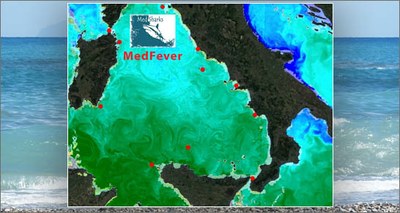Environment: Mediterranean Day, a network of sensors to determine seawater temperature
29/7/2021
 A network of thermometer-sensors deployed underwater which measure temperatures of the Tyrrhenian Sea every 15 minutes to understand how global warming affects submerged ecosystems.
A network of thermometer-sensors deployed underwater which measure temperatures of the Tyrrhenian Sea every 15 minutes to understand how global warming affects submerged ecosystems.
This is the goal of the project MedFever, presented on the International Day of the Mediterranean Sea, which comprises ENEA (scientific partner), the association MedSharks, the company Lush and a group of volunteer scuba divers from diving centers in Tuscany, Lazio, Campania, Calabria, Sicily and Sardinia. In order to measure sea temperature, marine thermometers will have to acquire the temperatures in the entire water column - not detected by satellites – and to this aim they will be placed, both offshore and inland, in ten strategic points of the Tyrrhenian Sea: Castellammare di Stabia and Marina di Camerota (Campania), Giglio island (Tuscany), Nettuno and Ponza island (Lazio), Scilla (Calabria), Ustica island (Sicily), Santa Teresa di Gallura, Capo Figari and Gulf of Cagliari (Sardinia).
"These 'thermometers' will allow extremely frequent measurements, crucial for all those involved in the monitoring, management and exploitation of the local marine environment. The data collected will allow us to observe and better understand coastal dynamics of extreme importance" , pointed out Ernesto Napolitano, oceanographer of the ENEA Climate Modeling and Impact Laboratory.
"In addition - he said - they are an amazing tool to study the state of the sea and its circulation, optimize forecasts and assess the impact of marine warming also on tourism, transport, maritime trade and, in particular, on energy production from sea currents and waves, a sector in which we have been working for years as part of the program agreements with the Ministry of Economic Development”.
In addition to contributing to selecting sites and calibrating the survey instruments, ENEA provides the innovative Mediterranean circulation model "MITO" [1], capable of providing forecasts on temperature, salinity and speed of sea currents with a spatial detail up to a few hundred meters. Developed and managed by the ENEA Laboratory of Climate Modeling and Impacts as an evolution of the model developed by the MIT in Boston, MITO uses the ENEA CRESCO6 supercomputer, currently the second infrastructure in Italy for computing capacity (1.4 million billion mathematical operations per second).
But the innovative aspect of the project is Citizen science, the practice of public participation in research, which in this case involved a group of volunteer divers from 10 diving centers who helped installing sensors in the 10 selected sites.
"The sea acts as our planet's 'radiator', a vast heat reservoir that supplies energy to the climate system; any anomalies can result in increasingly hot summers and increasingly extreme events that weaken aquatic organisms, triggering increasingly frequent mass mortality phenomena”, Eleonora de Sabata, President of MedSharks and coordinator of the project, pointed out.
"Hence - he continued - the importance of monitoring the Mediterranean temperature more widely. MedFever has the purpose of integrating the oceanographic stations, very complex to install and manage, with small observatories, initially in the Tyrrhenian Sea and then in other Italian seas. Lush contributed to purchasing thermometers and divers and diving centers helped install them ".
The 'voluntary' monitoring network stems from MedSharks, an association dedicated to the study and conservation of the Mediterranean environment which for five years has constantly measured the temperature in an underwater oasis in the Gulf of Naples. Over the years these data, collected to study the small Leopard shark, have opened an entirely new perspective to oceanographers and marine biologists on what happens under the sea.
According to a study conducted by an international team of scientists which includes ENEA researchers, the Mediterranean has the highest warming and salinity variation rate in the world and has become an actual hot spot of ocean warming, with a progressive involvement of the deeper layers.
For more information please contact:
Ernesto Napolitano, ENEA – Climate Modeling and Impact Laboratory - email: ernesto.napolitano@enea.it
For the Model MITO: https://giotto.casaccia.enea.it/mito/
Free videos:
- MedFever: il Mediterraneo com'è e come sta diventando
- MedFever i termometri
- MITO, il modello previsionale ENEA del Mediterraneo
Press Release “Environment: Ocean temperatures at a record high - Mediterranean Sea the warmest and getting saltier”
